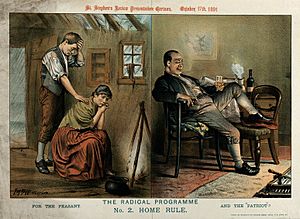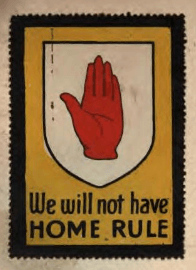Irish Home Rule movement facts for kids
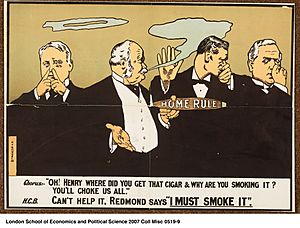
The Home Rule movement was a big political effort that wanted Ireland to have its own government. This was called "home rule." The idea was for Ireland to govern itself, but still be part of the United Kingdom of Great Britain and Ireland. This movement was the main way Irish people showed their desire for self-rule from 1870 until the end of World War I.
Isaac Butt started the Home Government Association in 1870. This group later became the Home Rule League in 1873, and then the Irish Parliamentary Party in 1882. These groups worked to get home rule passed in the British Parliament.
Under the leadership of Charles Stewart Parnell, the movement almost succeeded. The Liberal government, led by William Ewart Gladstone, tried to pass the First Home Rule Bill in 1886. But the bill failed in Parliament because some Liberal politicians disagreed. After Parnell died, Gladstone tried again with the Second Home Rule Bill in 1893. This bill passed in the House of Commons but was stopped by the House of Lords.
In 1911, a new law called the Parliament Act limited the power of the House of Lords. This meant they could no longer completely block bills. So, the Third Home Rule Bill was introduced in 1912. This led to a big problem called the Home Rule Crisis. The bill became law shortly after World War I began, but its start was put on hold until the war ended.
After the Easter Rising in 1916, especially because of the arrests and executions that followed, many Irish people started supporting the more radical Sinn Féin party instead of the Home Rule movement. In the 1918 election, the Irish Parliamentary Party lost badly, which ended the Home Rule movement.
The Sinn Féin politicians who were elected didn't just want home rule. They wanted full independence. They set up their own parliament, called Dáil Éireann, and declared Ireland a republic. Britain then passed a Fourth Home Rule Bill, the Government of Ireland Act 1920. This law aimed to create separate parliaments for Northern Ireland and Southern Ireland. The Northern Ireland parliament started in 1921 and still exists today as part of the UK. But the Southern Ireland parliament never really worked.
After the Anglo-Irish Treaty ended the Anglo-Irish War, most of Ireland became the Irish Free State in December 1922. This was a self-governing area within the British Empire, which later became the Republic of Ireland.
Contents
Historical Background of Home Rule
Before 1801, Ireland and Great Britain were separate kingdoms. But on January 1, 1801, they joined to form the United Kingdom of Great Britain and Ireland. This was done through the Act of Union 1800.
Throughout the 1800s, many Irish people did not like being part of the Union. Sometimes, this led to violent uprisings. In the 1830s and 1840s, a leader named Daniel O'Connell tried to undo the Act of Union. He wanted to bring back the Kingdom of Ireland but still keep the King of Great Britain as Ireland's king. His movement ended when a planned large meeting was cancelled by the authorities.
Until the 1870s, most Irish voters chose politicians from the main British parties, like the Liberals and Conservatives. For example, the Conservatives won most seats in Ireland in the 1859 election. However, some politicians, called Unionists, strongly opposed any changes to the Act of Union. In 1891, they formed the Irish Unionist Alliance to fight against home rule.
Different Ideas of Home Rule
The term "Home Rule" was first used in the 1860s. It meant that Ireland would have its own parliament to handle local issues. From the 1870s, many saw it as part of a larger plan for the United Kingdom. Ireland would have its own parliament, but the main British Parliament in Westminster would still manage big issues like foreign affairs.
Other groups, like the Fenians, wanted complete separation from Britain, even if it meant fighting. For a while, they worked with Home Rulers. Charles Stewart Parnell aimed for a parliament in Dublin with limited powers as a first step.
For Unionists, Home Rule was a worry. They feared a Dublin parliament would be controlled by the Catholic Church. They also worried it would harm Ireland's economy and threaten their identity as both British and Irish.
In England, the Liberal Party under William Ewart Gladstone was committed to Home Rule. But the Conservatives tried to solve Ireland's problems in other ways, hoping to make Home Rule unnecessary. For example, they passed laws to help farmers buy land and set up local governments in Ireland.
The Fight for Home Rule
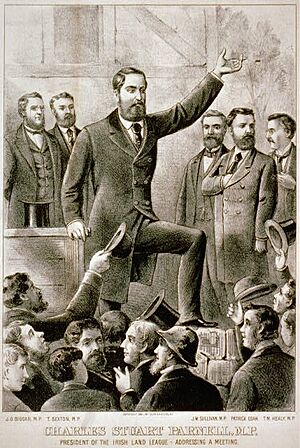
Isaac Butt, a former lawyer, helped connect different Irish nationalist groups. In May 1870, he started the Irish Home Government Association. In November 1873, it became the Home Rule League. This group wanted limited self-government for Ireland within the UK. In the 1874 election, candidates linked to the League won 53 seats in Parliament.
Butt died in 1879. In 1880, a young Protestant landowner named Charles Stewart Parnell became the leader. In the 1880 election, the League won 63 seats. In 1882, Parnell turned the Home Rule League into the Irish Parliamentary Party (IPP). This became a very strong political party that took over Irish politics. In the 1885 election, the IPP won 85 out of 103 Irish seats.
The House of Lords and Home Rule Bills
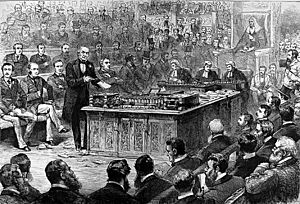
British Prime Minister William Ewart Gladstone and his Liberals tried twice to pass Home Rule bills. Gladstone believed strongly in giving Ireland self-government. In 1886, he gave a famous three-hour speech, asking Parliament to pass the Irish Government Bill 1886. But his bill was defeated in the House of Commons by 30 votes.
This defeat led to serious riots in Belfast and caused some Liberals to leave the party. These "Liberal Unionists" joined with the Conservatives to oppose Home Rule.
Gladstone lost power for a while. But after the 1892 election, he returned as Prime Minister. Even after Parnell's death, Gladstone tried again with the Irish Government Bill 1893. This bill passed the House of Commons but was defeated by the House of Lords. The House of Lords had a majority of Conservatives and Unionists who opposed Home Rule.
After this defeat, the new Liberal leader, Lord Rosebery, promised that English politicians would have a final say on any future Home Rule bills. The Home Rule movement then faced some internal divisions in the 1890s. The Liberals lost the 1895 election, and the Conservatives stayed in power until 1905.
Home Rule Bills Introduced

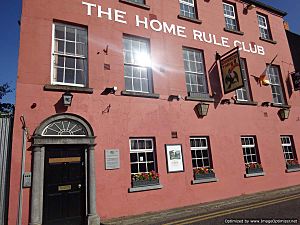
Four Home Rule bills were introduced in the House of Commons of the United Kingdom between the late 1800s and early 1900s. They aimed to give Ireland self-government within the United Kingdom and undo parts of the Acts of Union 1800.
Here are the four bills:
- 1886: The First Irish Home Rule Bill was defeated in the House of Commons.
- 1893: The Second Irish Home Rule Bill passed the House of Commons but was defeated by the House of Lords.
- 1912–1914: The Third Irish Home Rule Bill passed because of the Parliament Act, which limited the Lords' power. It became law in 1914 but was never put into action because of World War I and the Easter Rising in Dublin.
- 1920: The Fourth Irish Home Rule Act replaced the Third Act. It created two separate Home Rule areas in Ireland: Northern Ireland and Southern Ireland. Northern Ireland's parliament was set up, but Southern Ireland's was not. This led to the partition of Ireland and Ireland's independence through the Anglo-Irish Treaty.
In 1920, a Unionist politician named Lord Monteagle of Brandon suggested his own bill. It would have given a united Ireland wide-ranging home rule as a self-governing area within the British Empire. But his bill was also defeated.
Home Rule Almost Happens

After the 1895 election, the Conservatives were in power for ten years. During this time, the Local Government (Ireland) Act 1898 was passed. This law allowed local people to vote for their local councils, which was a kind of local home rule.
In the 1906 election, the Liberals won a large majority. But Irish Home Rule was not their main goal at first. However, after the December 1910 election, the Irish Parliamentary Party, led by John Redmond, held the balance of power in Parliament. This meant they could decide which party formed the government.
Prime Minister H. H. Asquith made a deal with Redmond: if Redmond supported a plan to limit the power of the House of Lords, Asquith would introduce a new Home Rule Bill. The Parliament Act 1911 then forced the Lords to accept that their power to block bills was limited to two years.
The Third Home Rule Bill was introduced in 1912. Like the earlier bills, it was strongly opposed by Ulster Unionists. They saw Home Rule as a threat to their Protestant faith and their British identity. They also worried it would hurt their economy.
Leaders like Edward Carson and James Craig helped organize the Ulster Covenant. This was a pledge against forcing Ulster into Home Rule. They also formed the Ulster Volunteers in 1912. In response, Irish Nationalists formed the Irish Volunteers in the south.
The Third Home Rule Act became law on September 18, 1914. But a special law put it on hold for the duration of World War I, which had just started. Most people thought the war would be short.
Changes and New Realities
When World War I began, the Irish Volunteers split. Many joined the National Volunteers and followed Redmond's call to support the Allied war effort. They joined Irish regiments in the British Army, hoping this would ensure Home Rule would be put into action after the war. The Ulster Volunteers also joined the British Army. Many Irish soldiers died in the war.
A smaller group of Irish Volunteers, who opposed supporting Britain, staged the Easter Rising in Dublin in 1916. At first, many people in both Britain and Ireland condemned the Rising. But the British government handled the aftermath badly, including quickly executing the leaders. This led to a huge increase in support for an Irish republican party called Sinn Féin. This small party was taken over by the survivors of the Easter Rising.
Britain tried twice more to put Home Rule into action, but both attempts failed. This was mainly because Ulster Unionists strongly protested against Home Rule for the whole island. After the war, public opinion shifted even more towards Sinn Féin and wanting full independence. Interest in Home Rule began to fade.
Home Rule Becomes Law (and Ireland Divides)
After World War I ended in November 1918, Sinn Féin won a huge majority of 73 Irish seats in the general election. The Irish Parliamentary Party was almost completely wiped out, winning only six seats. It soon broke up.
In January 1919, twenty-seven Sinn Féin politicians met in Dublin. They declared themselves an independent parliament for an Irish Republic. Britain ignored this, and the Irish War of Independence (1919–1921) began.
Britain still went ahead with its promise to implement Home Rule. They passed a new law, the Government of Ireland Act 1920. This law formally divided Ireland into Northern Ireland and Southern Ireland.
The Parliament of Northern Ireland began in June 1921. At its opening in Belfast City Hall, King George V gave a famous speech calling for peace between Britain and Ireland, and between North and South.
Southern Ireland's parliament never really worked. Instead, the Anglo-Irish Treaty led to the creation of the Irish Free State. This new state later became the Republic of Ireland.
The Parliament of Northern Ireland continued until March 30, 1972, when it was suspended during a period of conflict known as The Troubles. It was later officially ended. Since then, different versions of the Northern Ireland Assembly have brought back self-rule. These assemblies try to balance the interests of Unionists and Republicans through a "power sharing" agreement.
See also
 In Spanish: Home Rule (Irlanda) para niños
In Spanish: Home Rule (Irlanda) para niños
- Irish issue in British politics
- Edward Carson
- James Craig
- Charles Stewart Parnell
- John Redmond
- John Dillon
- John O'Connor Power
- William O'Brien
- Hugh Heinrick
- Loyalist Anti-Repeal Union
- Parliament of Southern Ireland
- Parliament of Northern Ireland
- Solemn League and Covenant (Ulster)
- Unionists (Ireland)
- Devolution
- Easter Rising
- Gladstone's Irish Home Rule speech
- Local Government (Ireland) Act 1898
- History of the Republic of Ireland
- Partition of Ireland
- History of Ireland (1801–1923)


